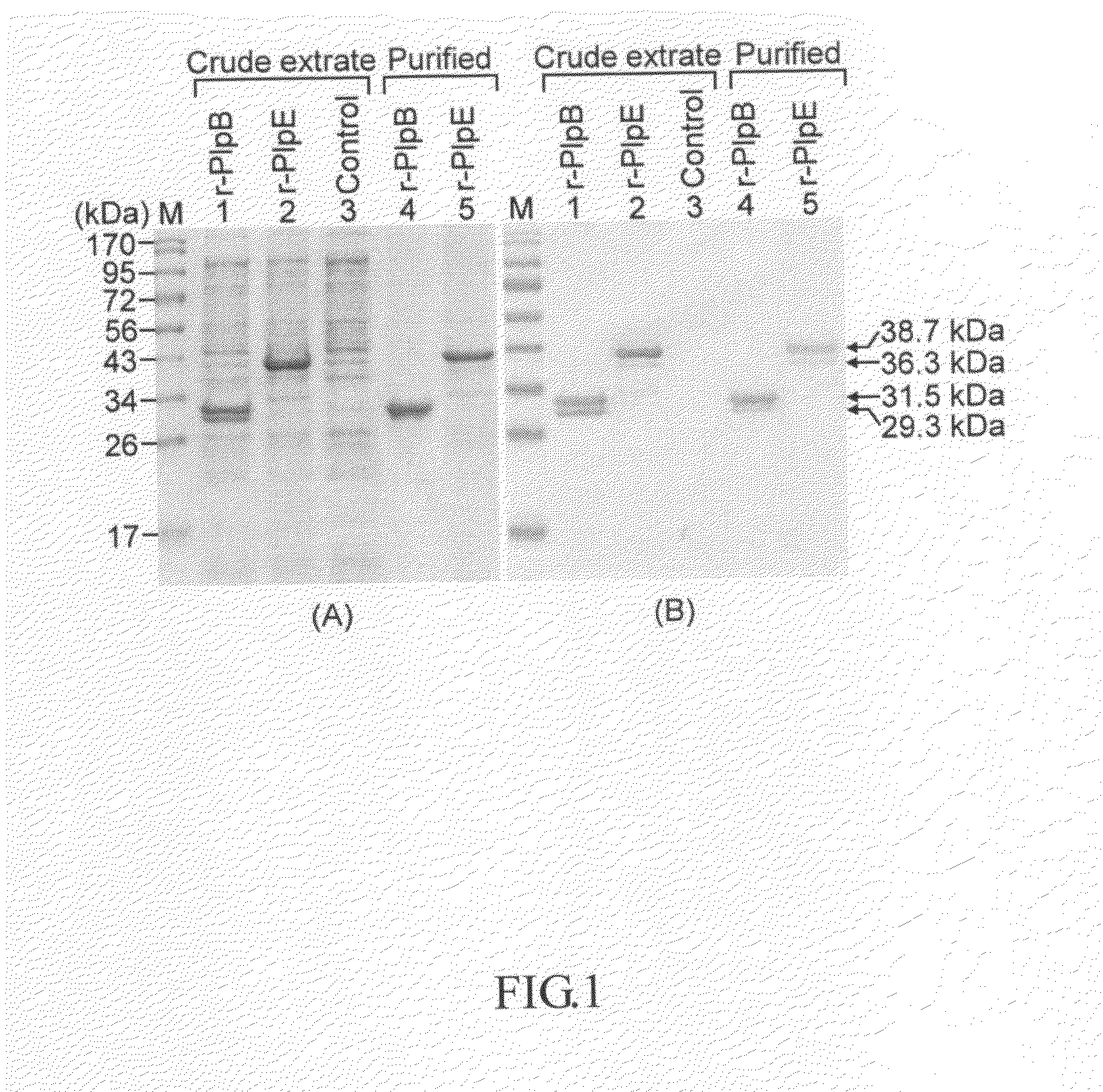Subunit vaccine of pasteurella multocida in veterinary uses
- Summary
- Abstract
- Description
- Claims
- Application Information
AI Technical Summary
Benefits of technology
Problems solved by technology
Method used
Image
Examples
example
Example 1
Preparation of Recombinant Lipoprotein E (r-PlpE) of P. multocida in E. coli
[0010]A. Bacterial Strains and Genomic DNA Extraction of P. multocida
[0011]P. multocida standard strains X-73 (A:1), P-1059 (ATCC 15742) (A:3), and P-1662 (A:4) were grown at 37° C. in brain-heart infusion (BHI) broth (Difco Laboratories, MI, USA) for 18-24 hours. Bacterial genomic DNA was isolated using the DNeasy tissue kit (Qiagen, Hilden, Germany).
B. Genetic Cloning and Expression Vector Construction for Recombinant Lipoprotein E (r-PlpE)
[0012]One set of primers, P1 / P2, was used to amplify the plpE gene from P. multocida strain X-73. The amplified genes were then used for expressing recombinant PlpE (r-PlpE) in E. coli. The sequences of primers P1 / P2 were as follows. P1: 5′-CCA TGG GCA TGA AAT TAA CAA AAC TTT T-3′, and P2: 5′ AAG CTT CCA ACC TTT AAC TAC ACC ACC-3′. These primers contained restriction enzyme (NcoI or XhoI) cutting sites at their 5′-ends (underlined sequences), followed by seque...
example 2
Evaluation of Protective Effects of r-PlpE Subunit Vaccine in BALB / c Mice Model
[0017]Three experiments were conducted in BALB / c mice. In experiments 1 and 2, groups of 6-week-old mice were immunized subcutaneously with 10 microgram of purified r-PlpB or r-PlpE in aluminum hydroxide adjuvant (Sigma-Aldrich Co., MO, USA), either alone or together with a bacterin composed of 1.25×107 or 2.5×107 CFU of formalin-inactivated P. multocida X-73 (A:1). Two weeks after immunization, mice were challenged with subcutaneous injection of 10-20 LD50 of strain X-73. In experiment 3, mice were immunized as described for experiments 1 and 2. Two weeks after immunization, mice were challenged with subcutaneous injection of 10 LD50 of strains P-1059 (A:3) or P-1662 (A:4), or strain T2A5 (which is a designated challenge strain used in drug inspection in Taiwan). All mice challenged were observed for 10 days and their survival rates were recorded. The results are summarized in Table 1. For statistical an...
example 3
Evaluation of Protective Effects of r-PlpE Subunit Vaccine in SPF Chicken Model
[0021]Three experiments in SPF chickens were conducted. In experiment 1, groups of 3-week-old SPF chickens were immunized subcutaneously with 100 microgram of purified r-PlpB or r-PlpE in complete Freund's adjuvant (Sigma-Aldrich). Three weeks after the primary immunization, a booster immunization was conducted, and three weeks after booster immunization, chickens were challenged with intramuscular injection of 3.6×103 CFU of strain X-73 or 5.5×108 CFU of strain P-1662. In experiments 2 and 3, chickens were immunized subcutaneously twice with 125 microgram of a crude extract of r-PlpE in a double emulsion adjuvant with a 3-week interval between immunizations. The crude extract was prepared by sonicating the pellet of E. coli that expressed r-PlpE. The double emulsion adjuvant contained Marcol 52 oil (63%), Arlacel A (7%), and Tween 80 (1.5%). Three weeks after booster immunization, chickens were challenge...
PUM
| Property | Measurement | Unit |
|---|---|---|
| Fraction | aaaaa | aaaaa |
Abstract
Description
Claims
Application Information
 Login to View More
Login to View More - R&D
- Intellectual Property
- Life Sciences
- Materials
- Tech Scout
- Unparalleled Data Quality
- Higher Quality Content
- 60% Fewer Hallucinations
Browse by: Latest US Patents, China's latest patents, Technical Efficacy Thesaurus, Application Domain, Technology Topic, Popular Technical Reports.
© 2025 PatSnap. All rights reserved.Legal|Privacy policy|Modern Slavery Act Transparency Statement|Sitemap|About US| Contact US: help@patsnap.com

